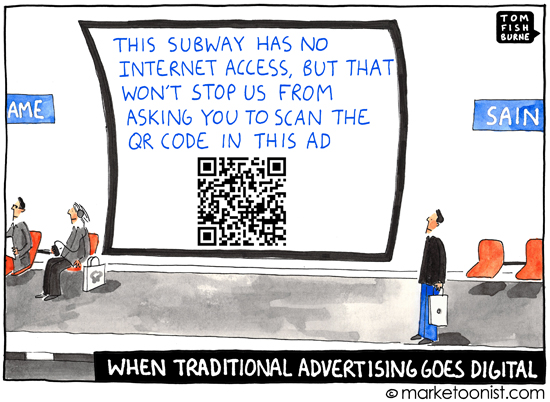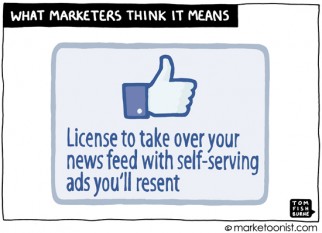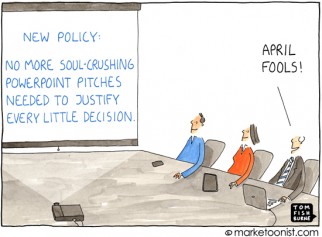We’re in the awkward adolescent stage of integrated media. There is still a great divide between traditional and digital brand communication. This becomes obvious in the disjointed way that many brands talk to consumers offline and online and the clumsy calls-to-action from traditional media to digital.
It always cracks me up when I’m asked to scan a QR code in an underground subway station with no internet access. Recently I saw an ad with a QR code on the other side of the subway tracks. Not only was there no internet access in that subway, the QR code was printed so small that anyone wishing to scan it would need to climb down onto the tracks and step over the third rail to get close enough to scan it with a mobile phone. And if there had, magically, been internet access, I suspect that the QR code would only have directed the browser to their general desktop website.
For consumers, the lines are blurred. There is no online or offline. Consumers consume all types of media. My 16-year old niece doesn’t really distinguish between the conversations she has with her friends over Instagram or the conversations she has with her friends in person. They’re all just conversations.
Brands, however, separate online and offline conversations into distinct silos, often managed by different agencies. Many traditional agencies stumble with digital campaigns. Many digital agencies stumble with brand building.
The opportunity for marketers is to create experiences that makes sense across all of these touch points, and always to judge communication from the point of view of our consumers. The next generation of integrated media will be truly integrated.
(Marketoonist Monday: I’m giving away one signed print of this week’s cartoon. Just share an insightful comment to this week’s post by 5:00 PST on Monday. I’ll pick one comment. Thanks!)



Gerald Hensel says
After Second Live disappeared somebody wrote: “Second Live was great. Finally ad agencies could do what they wanted to do in the first place – build stores and put up billboards.” It’s the same with QR codes. They don’t give a shit what it means or whether it’s usable. It is a) visual, b) it somehow looks tech and c) nobody gets it. It perfectly illustrates their mental model of the web.
Can I get the print please? 🙂
Tony Mariani says
I love when they put a qr code on busboards!
Pontus says
Gerald makes a very good point. To many agencies digital is actually about the fear of looking like they are not up to date, or doing the latest thing. So they will latch on to anything, QR codes etc, without thought or plan. Many companies, or at least their marketing departments, works in the same way.
By the logic of the business world I should get the print, since I took Gerald’s point and restated it, using slightly different words. 🙂
DSprogis says
I laughed out loud!
Gerald and Tony make great points.
I have seen the mindless and disconnected hand of advertising in cinema. My vision, CineCast[.com], was to offer an “editorial” approach by splitting the screen into windows and providing editorial value along with advertisements. But nooooo. Advertisers would not let go of the full screen. Too bad, I think it would have been refreshing.
Thanks for the Laugh Tom!
Steve WIllson says
I remember seeing QR codes as you described on the Toronto subway a couple of years ago and thinking how risky it would be to try and scan them…maybe from a stopped train, if it stopped at exactly the right point, if the windows were clean enough, if you happened to facing the window rather than the interior of the car…
It’s the same frustration I have with digital editions of magazines. If you’re only offering me a pdf version of your paper edition, then it’s a waste of my time and money. Look at National Geographic to see how to do digital editions well!
Faris says
I wrote a blog post about integrating online and offline marketing efforts last month. This illustrates the point beautifully!
http://www.digitalbuzz.me/elevate-your-social-media-presence/
Susie Wyshak says
I conceived of a qr code-like idea in the London tube in 2005 but based on texting a shortcode to a number that would return a url. You mapped out the use case for this dumbphone solution!
Barry says
We’ll here’s to hoping NFC chips change the future. I’m sure future editions of NFC tech will evolve and be able to carry data (Such as an image, small micro-site, document) and hopefully be powered by solar or something green. Which will eventually enable “Scanning” a bill board from across the train platform and without the need of wi-fi. Until then, feast on the QR codes, even if they don’t serve your appetite.
Mariana Quiroga says
I was jut talking about this yesterday – lots of ads with QR codes on the Delta Airlines in-flight magazine. I did pay for wi-fi access, but on my laptop, not my mobile. However the ad did not give me any URL, only a scan option… #fail =)
Sure, I can take the magazine with me, but these ads weren’t that compelling.
Paul (from Idea Sandbox) says
The problem isn’t the technology or tools, but the lack of consideration and laziness by the marketer.
Some marketers just want customers to do what they want. We almost don’t care sometimes if it even sells something… Oh… look the number of likes we have! Oh, we had 150 scan our QR code last month… You made the consumer join, or click, or fill out your form, or send in 5 UPC codes.
Whooppee!
But, did you make a meaningful connection with the potential customer? Did you do something to engage them? And engage meaning doing something the customer enjoyed – not jumping thru your marketing hoops.
Feels great to have those 5,000 Twitter followers you bought… Or perceived increased traffic from bogus weblinks.
Let’s say the QR code did work. That the marketer did his homework and knew you’d be able to scan underground… What was on the other end of that code? Another crummy ad? This time it is on my phone instead of the wall? Ah… but you can count the scans… right?
How great would it be if you rewarded me for scanning the QR code? Treated me special for jumping thru your marketing hoop? Not just a different version of the same ad.
With every tool we are given to reach our potential audience, we have to stop using it turned up full blast. Our job isn’t to stun our customers into submission, but create meaningful marketing… engage them… build trust, and be relevant.
Concetta says
We often talk shop about QR codes here, Tom! So many people don’t know how to use them and just throw them on a product or ad because “it can’t hurt, right?”
The coolest use I’ve seen for QR codes is for Vogue Knitting magazine. They often put the QR codes in the ads so you can see 360 degree video of the patterns in their pictures. Classic Elite Yarns does something similar, where the QR codes are on their yarn and you link to a yarn portal for them where you can see patterns for that particular yarn.
QR codes are so mis-used though. I wouldn’t be surprised if they died a quiet death because no one can really make a good argument for their effectiveness.
Ingrid says
I’m not sure marketers are always the problem. I’ve worked across a few categories in the last couple years where I’ve been barraged by requests from our salespeople (and the category buyers!) to put a QR code on packaging or in communications. Buyers seem convinced that QR codes are the ‘end all, be all’, but I’ve not seen evidence yet that consumers are very interested/see the value.
Janine Heffelfinger says
Sometimes clients fall in love with a particular tool – like QR codes. Tom, your subway story reminded me of a golf course marketing manager I had for a client a few years ago. Once she discovered QR codes, they had to go on everything. This included a billboard on a busy highway in Northern Wisconsin where the traffic zoomed by at over 70mph. In order to scan the QR, someone would have had to quickly pull out of fast traffic, slow down to 10 mph, drive partway across a field and hang out a window with a cell phone.
Steve B says
This is a great cartoon. Another thing that bothers me are Shazam tags on TV commercials that only run for like 5 seconds. Do they think that we have our mobiles up and facing the TV just waiting for them to let us use Shazam? It’s a good idea to get people involved in a TV spot but I’ve never been able to grab my phone, unlock it, and get Shazam open in time. Maybe it’s my fault for being too slow?
Frank says
It’s even worse. I scanned some of the QR codes once (of course with my smartphone) but none of them was linked to a mobile website!
Rob T. says
The broadening gap from traditional media to digital media has created a stampede mentality among marketers that results in potentially great technologies getting absolutely DESTROYED by ignorant and maligned use.
QR Codes are the poster child for this concept. What should have served as the bridge from the offline or printed world to the digital world with simple calls to action and simple consumable content, instead acted as a conduit to the frustration and annoying world of tiny text, massive graphics and delivery of a poorly designed homepage of a site that I really didn’t care to see.
Then when you add the fact that marketers started linked to rich media like YouTube, the deadly load times were made even worse.
In my opinion, this Marketoon speaks volumes to the lack of planning, and cluelessness that is becoming pervasive in marketing today. In that stampede of dullness and me-tooism, many marketers are completely losing sight that the customer experience with their brand, any experience, has a potential to help or destroy their perception of the brand.
There is a solution, and it’s not that difficult.
Think through the use of the media. Think through the experience, and take 2.687 seconds to think about how and where the consumer will interact or consume whatever media you are presenting. If it is likely to be a negative experience, or doesn’t do anything. Don’t do it. If you are doing it simply because your competitors are doing it, don’t do it.
Martin Pannier says
Personally, I just love that you took the Paris metro to illustrate your point 🙂
Glenn R says
Could not agree more!
QR Codes just seem to shout “Hey, Look at me! I’m digital! I’m so in the future and get you and your new ways of life”. The statistics show that not only do most people not scan QR codes – most people do not even realize that you need a special app to scan the QR codes (a lot think the phone’s camera can automatically do it).
Unless there is something really engaging on the other end of the QR code, it just seems like a waste of time – similar to putting a corporate hashtag that no one will actually use on the end of an ad.
asit gupta says
Assuming the message/call to action is compelling enough for consumers to want to follow up …There were 2 simple things mentioned in the comments which can make this follow-up/ link between offline and online easier: txt the short code (free) to receive a link to a mobile optimised destination. even if there is no signal ( leave alone 3G/data) the txt would be sent when you step out of the subway as it will be in the outbox.
tomfishburne says
Hi all,
Really great perspective on this one, thanks! This week’s print goes to Paul from the Idea Sandbox. He focused on the main issue. It’s not the technology. It’s the marketer’s creativity.
-Tom
FrankFisher says
Can’t see integration happening for a generation – why would people abandon their empires? Can anyone really see print teams voluntarily subsuming themselves into a greater comms team? For actual integration at agency level, brand managers need to integrate from day one, and face it, they might dream of doing that but as soon as they start planning or purchasing, the people they deal with will have their own favoured channels.
In 50 years, when everyone who has ever read a book right through without checking their email once has died, perhaps integration might come.